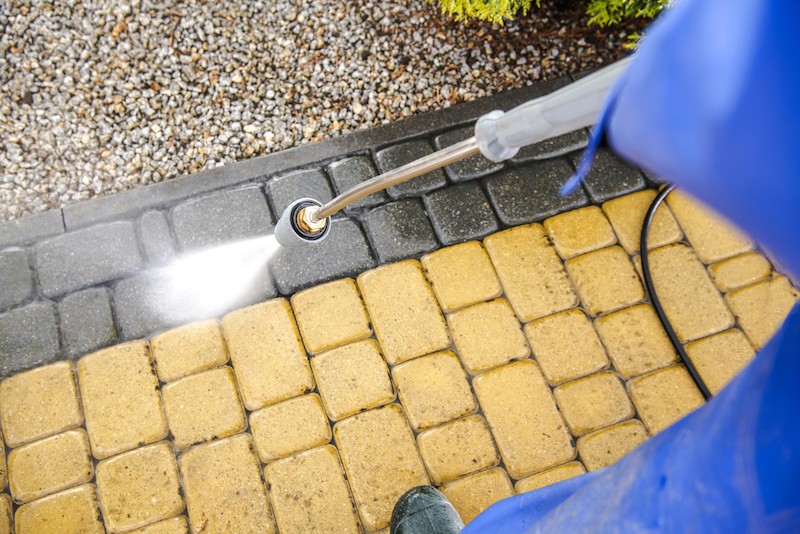
If you’ve been thinking about sealing your driveway, patio, deck, or even a fence, chances are you’ve heard that surface prep is key. And it’s true — if you apply sealant to a dirty or contaminated surface, it’s only a matter of time before it peels, cracks, or fades.
So, here’s the big question: Can power washing help prepare surfaces for sealing? Absolutely. In fact, it’s often the most effective way to get your surfaces ready for a proper seal. 🧽✅
In this article, we’ll walk you through:
- Why power washing is crucial before sealing
- Which surfaces benefit the most
- The do’s and don’ts of power washing before sealing
- How long to wait before applying sealant
- And common mistakes to avoid
Let’s dive in! 👇
🧽 Why Power Washing Before Sealing Is So Important
Think of sealing like painting your surfaces with an invisible shield. But if the surface is coated in grime, mold, or oil, that shield won’t stick — or worse, it will trap in moisture and dirt, leading to problems later on.
Here’s what power washing does before sealing:
✅ Removes embedded dirt and debris
✅ Lifts grease, algae, and mold
✅ Eliminates old sealant residue (if needed)
✅ Opens surface pores (especially for concrete and wood)
✅ Ensures maximum adhesion and durability of the new sealant
The cleaner the surface, the better the sealant bonds — which translates into a longer-lasting, better-looking finish. 🔒✨
🧱 Surfaces That Benefit from Power Washing Before Sealing
Here are some of the most common surfaces that should be cleaned with a pressure washer before sealing:
| Surface | Why It Matters |
|---|---|
| Concrete driveways 🧱 | Removes tire marks, oils, and opens surface pores |
| Pavers 🪨 | Eliminates weeds, dirt, and sand in joints |
| Wood decks 🪵 | Cleans mildew and prepares the grain for sealant |
| Fences 🌲 | Removes environmental grime and old coatings |
| Stamped concrete 🎨 | Brightens appearance and preps for clear sealers |
| Garage floors 🚗 | Clears oil, fluids, and general surface contamination |
Browse Amazon Here For Top Rated Power Washers And Accessories
🛠️ How to Power Wash Before Sealing (Step-by-Step)
Let’s break down the correct method for prepping surfaces via power washing:
1. Clear the Area
Move furniture, grills, potted plants, or vehicles away from the space. You don’t want to power wash around these and miss spots.
2. Apply Detergent (Optional, But Recommended)
A good concrete or wood-safe detergent helps lift stubborn grime, grease, and organic growth. Spray the solution evenly and let it dwell for 5–10 minutes (but don’t let it dry).
3. Use the Right Pressure
Too little pressure won’t clean effectively — too much may damage the surface.
| Surface | Recommended PSI |
|---|---|
| Concrete | 2,500–3,000 PSI |
| Wood | 1,200–1,500 PSI |
| Pavers | 2,000–3,000 PSI |
Use a wide-angle nozzle (25–40°) and maintain even distance.
4. Rinse Thoroughly
Rinse away all detergent and debris. Be especially careful to clear out cracks, crevices, and between pavers or deck boards.
5. Let It Dry Completely
This is a crucial step. Sealing too soon after washing can trap moisture, which leads to cloudiness, bubbling, or mold.
- For wood, wait 48–72 hours
- For concrete or pavers, wait 24–48 hours (longer in humid weather)
- Check for complete dryness — use a moisture meter for wood if possible
⛔ Common Mistakes to Avoid
❌ Skipping the Cleaning
Even if a surface looks clean, it may still have embedded contaminants that compromise sealant performance.
❌ Not Letting It Dry
This is one of the most frequent and costly errors. Never apply sealant to damp surfaces.
❌ Using High Pressure on Wood
Too much force can raise the grain or cause splintering, which affects stain and sealant absorption.
❌ Forgetting to Test a Small Area
Always spot-test your sealant after the surface has dried. This ensures there’s no adverse reaction or unexpected color shift.
🧴 Do I Need to Remove the Old Sealant First?
That depends on the surface and type of sealant.
- For wood surfaces, light power washing often lifts old water-based sealers
- For concrete, multiple layers of old sealer may require chemical stripping or specialized equipment
- If the old sealant is flaking or peeling, it must be fully removed for the new application to adhere properly
💡 Tip: If water beads up on your surface after cleaning, the old sealer may still be present and blocking absorption.
🌧️ What If It Rains After Power Washing?
If it rains before the surface dries fully, you’ll need to wait for another dry stretch before sealing. Moisture in the substrate can delay or ruin the sealant’s cure.
Plan your cleaning and sealing around a 3-day dry window for best results.
✅ Final Verdict
So — can power washing help prepare a surface for sealing?
Absolutely. It’s not only helpful — it’s often essential for:
🔹 Getting rid of dirt, grease, and old contaminants
🔹 Opening the pores of wood and concrete
🔹 Maximizing the lifespan and performance of the sealant
🔹 Ensuring a professional-looking finish
When done correctly, power washing is the foundation of an effective sealing job. Take the time to clean thoroughly, allow proper drying, and your sealed surface will look better — and last longer. 💪🔒✨
Browse Amazon Here For Top Rated Power Washers And Accessories






